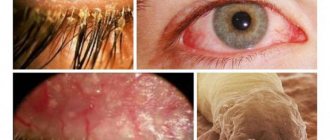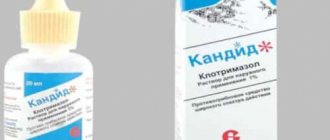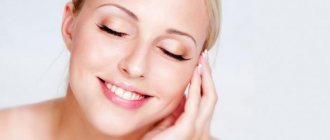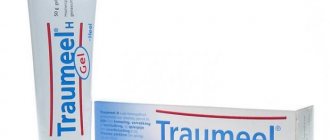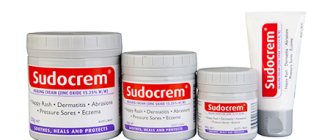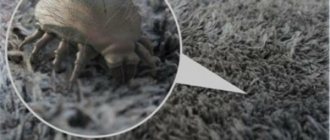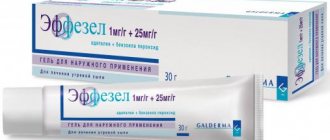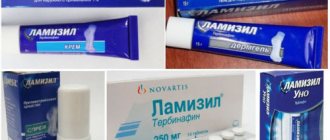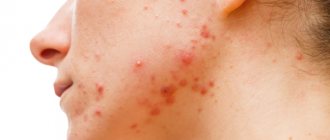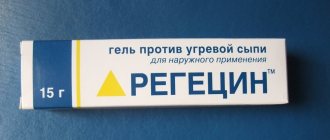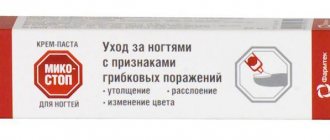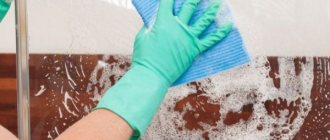Photo: skinhairandyou.com Rosacea is a vascular lesion expressed by stars, foci of suppuration, and bright rashes. Affects the skin of the face, back and chest.
- Diet for rosacea
As rosacea on the face progresses, it provokes thickening of the skin and irreversible infiltration. Due to pathology, the appearance deteriorates, a cosmetic defect leads to psychological problems, emotional instability, and social difficulties. If rosacea affects the eyes, keratitis, the formation of ulcers on the cornea, is possible.
More often, the pathology is diagnosed in women. Northern peoples are more susceptible to it. There are several theories of origin, but most of the reasons are controversial and have not been conclusively scientifically proven. The pathology is chronic, characterized by a high probability of relapse. There is no need to worry whether rosacea is contagious or not - the disease is not spread from person to person.
ICD code
In ICD-10, rosacea is coded L71. Within the L71 class there are:
- L71.0 – perioral type;
- L71.1 – rhinophyma;
- L71.8 – other varieties;
- L71.9 – unspecified form.
In the ICD-9-CM system, rosacea (rosacea) is encrypted with code 695.3.
This is interesting! Doctors have long known what rosacea and rosacea are. Both conditions are characterized by redness of the skin, but with rosacea the epidermis is smooth, and in the second case it is inflamed.
Causes
The causes of rosacea have been partially researched, but much remains to be learned. Main theories:
- Rosacea is a skin disease that appears due to external influences. Spicy, alcoholic, caffeine-containing foods, when supplied with food, affect the gastric mucous membranes, causing vascular dilation. It was previously believed that rosacea was associated with eating meat, but the theory was not confirmed, since the pathology was identified in vegetarians. Tests have proven that facial flushing often follows after drinking hot liquid.
- People whose loved ones have suffered from this disease often know what rosacea looks like from their own experience. The scientific community tends to err on the side of this belief, but several experiments have shown that 40% of patients have relatives with a similar diagnosis. Several cases of familial disease have been observed.
- Rosacea on the arms, face, back and chest can be due to infection. The pathology is accompanied by the formation of ulcers, and taking antibiotics can alleviate the symptoms. An examination of the contents of the rash did not show the presence of specific bacteria or viruses that provoke inflammation.
- Rosacea in men and women (according to some scientists) is explained by Demodex mites. When examining skin samples, these parasites are often identified. When treatment directed against them is prescribed, the disease weakens. Since ironitis is not found in all patients, when it is detected, rosacea-like demodicosis is diagnosed. Some believe that the development of Demodex colonies is a consequence of a skin disease.
- Rosacea in children and adults is possible due to digestive diseases. The theory is based on the results of statistical research. 35% of those suffering from rosacea have pathologies of the small intestine, more than half have gastritis. It is believed that the pathology develops under the influence of Helicobacter pylori.
- Rosacea on the nose, other parts of the face, and on the body is possible due to mental disorders. This theory has been dominant for a long time, although there is no definitive evidence to support it. It has been noted that in severe cases of skin disease, patients suffer from depression, instability of emotions, and are depressed.
Steroid rosacea.
Photo: cf.ppt-online.org The study of the etiology and pathogenesis of rosacea showed that the vessels of the patients’ faces are very sensitive to aggressive factors that do not affect healthy people. In some cases, medications can cause rosacea. A special form (steroid rosacea) develops when corticosteroids are applied to the face.
Risk factors:
- gastrointestinal pathologies;
- endocrine disruptions;
- weak immunity.
Possible causes of exacerbation:
- alcohol;
- hot food;
- spicy;
- spicy;
- long exposure to the sun;
- powerful emotions;
- wind;
- high or low ambient temperature.
More often people with blond and red hair, blue and green eyes, and white sensitive skin learn from their own experience what kind of disease this is - rosacea. A particular risk group is menopausal women, allergy sufferers and people living in harsh continental climates.
Comparison of side effects of Metrogil and Rozamet
Side effects or adverse events are any adverse medical event that occurs in a subject after administration of a drug.
Metrogil's side effects are almost the same as Rozamet's. They both have few side effects. This implies that the frequency of their occurrence is low, that is, the indicator of how many cases of an undesirable effect of treatment are possible and registered is low. The undesirable effect on the body, the strength of influence and the toxic effect of Metrogyl are similar to Rozamet: how quickly the body recovers after taking it and whether it recovers at all.
Symptoms of rosacea
The first symptom of rosacea is the rapid appearance of red spots on the face with:
- contact with hot or cold water;
- change in ambient temperature;
- drinking hot and alcoholic drinks.
At the first stage, redness is localized in the T-zone and does not attract attention, does not cause discomfort, and is hidden by cosmetics. Persistent capillary expansion leads to rashes, a local increase in temperature, and the proliferation of saprophytes. The second stage of rosacea is characterized by:
- uneven skin;
- tubercles;
- small ulcers;
- compaction of integument;
- roughness of the epidermis;
- swelling, redness without connection with aggressive factors.
Sometimes the disease manifests itself:
- brown-red papules;
- nodes;
- merging painful elements;
- lumpy skin.
In men, a typical symptom is redness and tightness of the nasal lining. Rhinophyma is often detected with rosacea. In subsequent stages, the eyelids and eyes suffer. Blinking is accompanied by unpleasant sensations, dryness, pain, which are replaced by lacrimation.
Frequent symptoms:
- teleengiectasia;
- burning of the skin;
- feeling of itching;
- tightness of the integument.
Clinical picture by stages:
- Periodic redness of the face and décolleté against the background of provoking factors. The frequency of attacks increases, individual zones acquire a persistent red, bluish color. The face swells and the skin peels.
- Papulopustular rosacea is the second stage. Accompanied by ulcers, pimples, group arrangement of rashes. The skin of the forehead and bridge of the nose is swollen, the skin is sensitive to the sun, prone to solar comedones. Ulcers cover the face, chest, and sometimes the back.
- The phymatoid stage is characterized by thickening of the integument and the appearance of bumps visually similar to an orange peel. Deep furrows form on the nose. Similar changes are possible in the eyelids, chin, forehead, and earlobes.
Rosacea on the cheeks. Photo: the-living-media.com
Contraindications
When using Metrogyl for acne, it is worth considering that it has some contraindications, but there are not so many of them. You should not use the gel if you have the following conditions:
- If there is individual intolerance to the constituent components, namely metronidazole;
- Not recommended for use in the first trimester of pregnancy;
- Contraindicated in case of impaired functioning of the liver and kidneys.
In general, the product combines well with other antibiotics. However, to avoid overdose symptoms, Amoxicillin should not be used internally.
Important! In rare cases, the drug can cause unpleasant side symptoms - increased irritation, redness, dryness and flaking of the skin, itching in the area of application, and a feeling of tightness. If the gel gets into the eyes, it may cause watery eyes and a burning sensation.
Forms
The most common forms of rosacea are:
- erythematous-telangiectatic (with vascular network);
- papulopustular (with papules, pustules, skin infiltration);
- papular nodular rosacea (with nodes, plaques, glandular fibrosis);
- ocular (accompanied by blepharitis, conjunctivitis, keratitis and other eye inflammations).
The latter is often accompanied by fear of light, blurred vision, and lacrimation.
Forms of rosacea disease. Photo: lvrach.ru
Specific forms of Rosacea:
- conglobate, in which large balls form on the integument (due to taking drugs with bromine, iodine);
- steroid, associated with the use of hormonal ointments (the most difficult to treat);
- fulminant or complicated conglobate, rapidly progressing and greatly changing the face (more often seen in young people; treatment is ineffective);
- lymphoedema, a rare form characterized by severe purple swelling due to the proliferation of subcutaneous tissue.
The treatment regimen for rosacea is selected taking into account the identified form of the disease.
Types of rosacea. Photo: cf.ppt-online.org
Comparison of the effectiveness of Metrogil and Rozamet
Metrogyl is more effective than Rozamet - this means that the ability of the medicinal substance to provide the maximum possible effect is different.
For example, if the therapeutic effect of Metrogil is more pronounced, then with Rozamet it is impossible to achieve this effect even in large doses.
Also, the speed of therapy is an indicator of the speed of therapeutic action; Metrogyl and Rozamet are also different, as is bioavailability - the amount of a drug substance reaching the place of its action in the body. The higher the bioavailability, the less it will be lost during absorption and use by the body.
Pathogenesis
In case of skin pathology, due to various factors, the tone of the arterioles that nourish the facial integument changes. External influence:
- Sun;
- warm;
- cold;
- aggressive chemicals;
- spicy food;
- alcohol;
- hot drinks.
Internal factors:
- digestive problems;
- infection with Demodex mites;
- infection;
- endocrine disorders;
- weak immunity;
- susceptibility of the vascular wall to the influence of kallikrein-kinin coagulation systems.
Etiology of the pathogenesis of rosacea. Photo: rmj.ru
Diagnostics
When making a diagnosis, differential diagnosis is necessary, since the symptoms of Rosacea are similar to the following diseases:
- sarcoidosis;
- some forms of lupus;
- dermatomyositis;
- acne;
- perioral dermatitis.
Diagnosis of rosacea begins with a visual examination of the affected areas of the skin. Incorrect diagnosis and treatment of demodicosis instead of combating the root cause provokes a worsening of the condition and progression of rosacea.
Sometimes, assuming a diagnosis of rosacea, a microflora study is prescribed. Bacteriological analysis is necessary if vesicles and pustules appear. To determine the colonies of the gland, a skin scraping is taken.
Diagnosis of rosacea. Photo: osp.ru
Rosacea treatment
Treatment for rosacea on the face and body includes:
- selection of care;
- elimination of inflammation;
- exclusion of aggressive factors.
Basic rules for skin care for rosacea:
- washing with warm water;
- refusal of sauna, bath;
- protection from the cold with fatty creams;
- sun protection with special means;
- using a soft towel;
- refusal of heavy physical activity;
- choosing cosmetics without hormonal components for rosacea;
- avoiding cosmetics with ingredients that dilate blood vessels, heavy oils, and alcohol.
Diet for rosacea is an important element of the course. It is necessary to avoid alcohol, hot, spicy, sour, smoked, and caffeine-containing foods. You can't drink strong tea. The emphasis is on vegetables, fruits, and dairy products. Eat only warm food.
The success of treating rosacea at the initial stage is higher. If the disease is complicated by rhinophyma, the course becomes more difficult and takes longer. There is no single universally accepted scheme: rosacea is treated by identifying and correcting the individual factors that cause rosacea. The course of therapy takes from several weeks to several months. Combination treatment is most effective. After its completion, it is recommended to review care to minimize the risk of relapse. If erythematous rosacea does not attract attention, the disease transforms into a severe form.
Features of treatment depending on the form:
- for erythematotelangiectatic, laser, light treatment, and limited medication are indicated;
- for papulopustular cases, use metronidazole, ivermectin (cream for rosacea), sulfur sulfacetamide, antibiotics for rosacea (tetracyclines), isotretinoin (eg, Roaccutane), azelaic acid;
- for phimosis, isotretinoin is indicated (Acnecutane is often prescribed for rosacea), laser treatment, and surgery.
How long it takes to treat rosacea depends on the stage and severity of the disease. Sometimes the course lasts several weeks, in other cases - months.
When prescribing medications for the treatment of rosacea, concomitant diseases are taken into account. Often necessary:
- gastroprotectors;
- antacids;
- hepatoprotectors;
- choleretic;
- hormonal;
- vitamins;
- immunomodulators.
This is interesting! Only your doctor can decide whether Differin gel can be used for rosacea. Differin is intended for the treatment of mild to moderate acne, incl. in the presence of comedones, papules and pustules..
Drugs for the treatment of rosacea
Metronidazole for rosacea is one of the most commonly used medications. It relieves swelling, activates the regeneration of mucous membranes, destroys bacteria and iron. Trichopolum has the same effect for rosacea, since the active ingredient is metronidazole.
Sometimes tablets are prescribed for rosacea:
- oxytetracycline;
- tetracycline;
- minocycline.
Doxycycline is often prescribed for rosacea. After assessing the pathological microflora, they may recommend Unidox Solutab for rosacea. If you are allergic to tetracyclines, macrolides are indicated—Zinerit powder for rosacea containing erythromycin is prescribed.
For local effect, creams and gels are used to treat rosacea. Often prescribed:
- Quasix. Contains quassia extract. Eliminates discomfort and alleviates the patient's condition. This cream for rosacea on the face helps achieve stable remission with prolonged use.
- Skinoren for rosacea relieves inflammation and swelling, dries the skin. Contains azelaic acid. Apply to a dry, washed face. The effect is cumulative and manifests itself with constant use. Azelaic acid for rosacea is allowed for patients over 12 years of age. Skinoren gel for rosacea is prescribed to pregnant and nursing mothers after consultation with a specialist ( DO NOT apply to the mammary gland area before feeding! ). Azelik gel has a similar effect for rosacea.
- Help with rosacea: Rosamet, Rozex, containing metronidazole. Metrogyl gel has the same effect for rosacea. The drugs fight inflammation, reduce the concentration of ulcers, and even out the skin.
- Hormonal agents. Widely used in the past, now less common. They show a quick effect, but their cancellation is accompanied by a rollback of the state. There is a risk of developing steroid rosacea. If hormonal therapy is necessary, Akriderm is sometimes prescribed for rosacea.
- Ovante. Contains sulfur, plant extracts. Safe, indicated for long-term use.
Ovante cream for rosacea. Photo: vip-estetika.ru
- Sometimes heparin ointment is prescribed for rosacea. It relieves inflammation and reduces blood clotting. If used incorrectly, it can worsen the condition.
- Solantra cream for the treatment of rosacea is prescribed for papules and pustules.
- Elidel for rosacea is used to eliminate inflammation.
Additionally recommended:
- Ascorutin in case of severe telengiectasia;
- Suprastin, Tavegil, Cetrin for rosacea with severe itching, active inflammation;
- valerian, sage, chamomile for rosacea (will help calm down);
- sebosuppressors (inhibit sebaceous glands);
- Elokom for rosacea - in case of severe inflammation;
- aloe for rosacea for quick healing;
- preparations for keratinization.
Rosacea treatment regimen
There is no universal therapy. The course depends on the severity and form of the disease. Combination treatment is indicated:
- Oral antibiotics for the correction of rosacea, demodicosis, complications, secondary infection.
- Local treatment. Effezel stimulates recovery for rosacea, GCS eliminates inflammation. Stellanin accelerates recovery for rosacea.
- Vitamin therapy.
- Antihistamines.
- Sedatives.
- Physiotherapy.
Darsonval for rosacea on the face accelerates the restoration of the integument. Used as prescribed by a doctor.
Pharmacy cosmetics for rosacea
With rosacea, the skin needs special care. Choose products for sensitive skin. Necessary steps of the daily routine:
- cleansing;
- hydration;
- nutrition;
- Sun protection.
When choosing what to wash your face with rosacea, they give preference to soft cream products. Use them twice a day. If the skin is oily, use tar soap. Peeling is occasionally useful for rosacea. The procedure is agreed upon with a cosmetologist. Fruit acid compositions are preferred. Previously, GiGi multi-peel was often used for rosacea, but the product is no longer produced.
Moisturizing is the task of caring creams. Cetaphil cream has proven itself well for rosacea. The brands Uriage, Bioderma, and Aven have special lines. Pharmacy cosmetics for rosacea are the best choice because they contain a minimum of aggressive components and are designed for people with problematic, delicate skin.
Cosmetologists often recommend Bioderma for rosacea - lines of this brand are available in most pharmacies. They offer creams, lotions, and serums. The most useful is the Sensibio AR series.
Uriage cosmetics for rosacea create a protective barrier, preventing irritation of the skin. Roseliane series recommended.
Avene is recommended for rosacea because the creams contain vitamins and fatty acids that increase skin tone and relieve inflammation. The Antirougeurs line is preferred.
In order for cosmetics (for example, Libriderm brand) to show maximum effect for rosacea, they are selected in consultation with a doctor. Otherwise, there may be a conflict between the components of the medications and care formulations.
Gives a good effect:
- Ruboril from ISIS Pharma;
- Rosaliac from La Roche-Posay;
- Pharmaceris R from Dr.Irena Eris;
- Azelac Line from Sesderma;
- Rosacea Care by Rosacea Care.
Cosmetologists recommend retinoids for rosacea. When choosing products, take into account the sensitivity of the skin and the age of the patient. They start with the weakest options, gradually moving to products with more active ingredients, highly concentrated formulations.
Since it is known what is not allowed for rosacea, and one of the first prohibitions is sun exposure, it is necessary to regularly use sunscreen. They prefer creams with zinc and titanium. In gloomy weather, apply a single layer of protection, in sunny weather - several layers.
This is interesting! Rosacea is mentioned in classic works of literature, such as Shakespeare's The Comedy of Errors.
Treatment of rosacea with folk remedies
Many people use Chlorhexidine at home for rosacea. An antiseptic disinfects the skin, but dries the skin, so its use is not always wise. Tsindol is used in the same way for rosacea.
Popular folk remedies for rosacea on the face:
- calendula tincture (for lotions for 3 hours daily);
- chamomile decoction (for daily lotions);
- infusion of succession (for half-hour lotions);
- cranberry juice (apply as a lotion for 1 hour).
You can make masks for rosacea at home. The most popular is oatmeal. To prepare, grind the flakes, combine with boiling water and apply the paste to the face for an hour. Keep the mask for 40 minutes, regularly moisturizing with a napkin.
Healers recommend a kefir mask. Gauze is soaked in the product and applied to the face for 10 minutes.
Laser treatment for rosacea
Laser therapy is a progressive method of combating rosacea. During treatment, the laser beam glues damaged capillaries, lightening the spot and eliminating inflammation. Possible contact, non-contact effects, stable or labile procedure. Rules for treating rosacea with laser:
- the dose is selected by a specialist;
- up to 12 procedures are allowed per day;
- pause between courses - a month or more;
- Duration of the procedure - up to 10 minutes;
- For weather-sensitive people, a 4 times weaker laser is needed.
Laser for rosacea.
Photo: academy-pa.ru Contraindications:
- blood clotting disorder;
- tuberculosis;
- neoplasms in the treated area;
- diabetes;
- weakness of the heart, lungs, kidneys;
- angina pectoris;
- pregnancy;
- heavy, painful menstrual bleeding.
Description
Before you start using Metrogyl acne gel, you should find out what this product is. This drug is manufactured in India and is known to all pharmacists as “metronidazole”. It is called so because it contains the active substance - metronidazole.
It is this component that has a detrimental effect on many anaerobic microorganisms. This substance suppresses growth, the ability to reproduce, and relieves severe inflammatory processes that appear as a result of their increased activity.
Note! The gel ensures complete elimination of acne and pimples. However, it is worth considering one important nuance - this remedy will not help in cases where the skin rash appears as a result of the activity of the subcutaneous mite Demodex folliculorum. It also does not affect aerobic bacteria.
In pharmacies this drug is sold in aluminum tubes. The volume of one tube is 30 grams. Despite the fact that the volume of the gel is small, it lasts for a long period. This is due to the fact that it is not applied to the entire surface of the face, but only to the affected areas.
Prevention
Preventive measures:
- proper nutrition;
- protection from the sun, temperature changes;
- treatment of allergic, gastric, intestinal, endocrine, vascular pathologies;
- use of soft cosmetics.
After successful treatment, it is recommended to regularly visit a cosmetologist to monitor the condition of the blood vessels.
Diet for rosacea
If you are prone to rosacea, you need to know, in the case of rosacea, what you should not eat and what is allowed. Excludes:
- canned food;
- alcohol;
- animal fats;
- roast;
- spicy;
- vinegar;
- sausage;
- sweet;
- strong tea, coffee.
Useful:
- dietary meat;
- sea fish;
- eggs;
- vegetables;
- fruits;
- vegetable oils;
- leafy greens;
- fermented milk;
- cereals;
- bread made without yeast.
In very severe cases, therapeutic fasting is indicated. Duration - 5 days.
Indications for use
The antibiotic has a wide spectrum of action, so it is used not only to treat dermatological diseases.
The instructions indicate the following indications for which it is necessary to take an antibiotic:
- Sexually transmitted diseases – gonorrhea, syphilis, lymphogranuloma;
- Infectious diseases caused by chlamydia - trachoma, urethritis, prostatitis;
- Recommended for use in the presence of moderate, moderate and severe acne;
- To eliminate pink acne - rosacea;
- For infectious lesions of the microplasma type;
- To eliminate borrelosis;
- In the presence of infectious diseases in the lower respiratory tract - with pneumonia, with exacerbation of chronic bronchitis;
- Prescribed for the treatment of various gynecological infections - chronic endometritis, salpingoophoritis, adnexitis;
- For the treatment of wounds with infectious complications.
